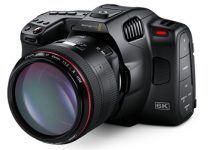The Sony A7s is a low-light monster no question about it.
The full-frame 12MP sensor with those humongous gapless photo sites sucks up incredible amounts of light to deliver clean video at relatively high ISOs. A feat unimaginable until just a few months ago from any DSLR in video mode.
However, the size of the full-frame sensor, as important as it is for video work, can also work to the camera’s disadvantage. When it comes to hand-held work the rolling shutter becomes a real issue for most DSLRs. The image wobbles from side to side like jello, and the effect can become quote distracting.
In previous generations of DSLRs, rolling shutter has been the Achilies heel for most cameras such as the 5D Mark II. No matter how fast the processing power of the camera is, when it comes to scanning an image line-by-line on a 36mm x 24mm full-frame sensor, this will take some time.

Until recently, most DSRL’s in video mode – scan the HD image from a full-frame or (APC-S) sensor by skipping certain lines in a process called “pixel-binning” in order to save time as opposed to reading every single line horizontally on a massive full-frame sensor.
This method unfortunately, although it doesn’t put so much stress on the internal processing, introduces some some unwanted artefacts in the HD output such as – moire and aliasing. Despite having the same size sensor and a faster readout, the 5D Mark II for example, produces far more artefacts in 1080p than the Sony A7s.
The latter features a processing pattern not seen on DSLRs before – “a full pixel readout” – meaning, every single line of that 36mm x 24mm full-frame sensor on the A7s is read, processed and output onto the final video file, without line-skipping. This way most, if not all, aliasing and moire are eliminated, but at the same time, the camera needs more time to scan the sensor – hence the pronounced “jello”/rolling shutter effect.

Ever since it was announced at NAB 2014, the Sony A7s has been the subject of speculations as to the severity of the rolling shutter effect, given the full-pixel readout and the full-frame sensor of the camera.
BMCuser.com forum member and DP, Ed David posted this Rolling shutter test between the Sony A7s and the Blackmagic Pocket Cinema Camera, which we think you might find quite interesting and helpful. Note, all these tests on the A7s were done in 1080p, as the 4K option is only available via an external recorder (Atomos Shogun) which is not out yet.
Hey Sony A7S! Let’s Rolling Shutter You Against Mr. Black Magic Pocket Camera BMPC from Ed David on Vimeo.
From the test above, it is evident that the rolling shutter on the Sony A7s is quite pronounced, when the camera is used hand-held without a rig. The micro-jitter effect even when there is only a slight movement of the camera is very obvious. The BMPCC holds it’s own quote well in terms of rolling shutter, but let’s not forget that the sensor of the Pocket Camera is only Super 16mm, which is close to 3 x less than a full-frame sensor.
The CPU is slow to read the full-frame sensor in 1080p mode, and probably even slower in 4K, but that is yet to be tested and determined, once the Atomos Shogun is released in September.

Still, the A7s shines in low-light, the texture of the image is quite filmic and the S-log 2 cine gamma, combined with the 50mbps XAVC-S codec, makes for more extensive colour correction options.
I personally love to shoot hand-held with a minimal rig, and I need to start thinking about either some sort of brushless motor stabilisation or a change in style of shooting, as the A7s is definitely not a great option for pure hand-held “run-and-gun” type of shooting. A shoulder rig (preferable a heavier one) maybe with an Easy-Rig can alleviate the rolling shutter effect on the Sony A7s.
What do you guys think? Is the rolling shutter on the A7s tolerable? Or a deal-breaker? Let us know in the comments below.
Disclaimer: As an Amazon Associate partner and participant in B&H and Adorama Affiliate programmes, we earn a small comission from each purchase made through the affiliate links listed above at no additional cost to you.



